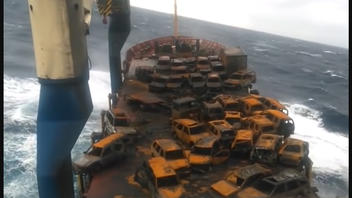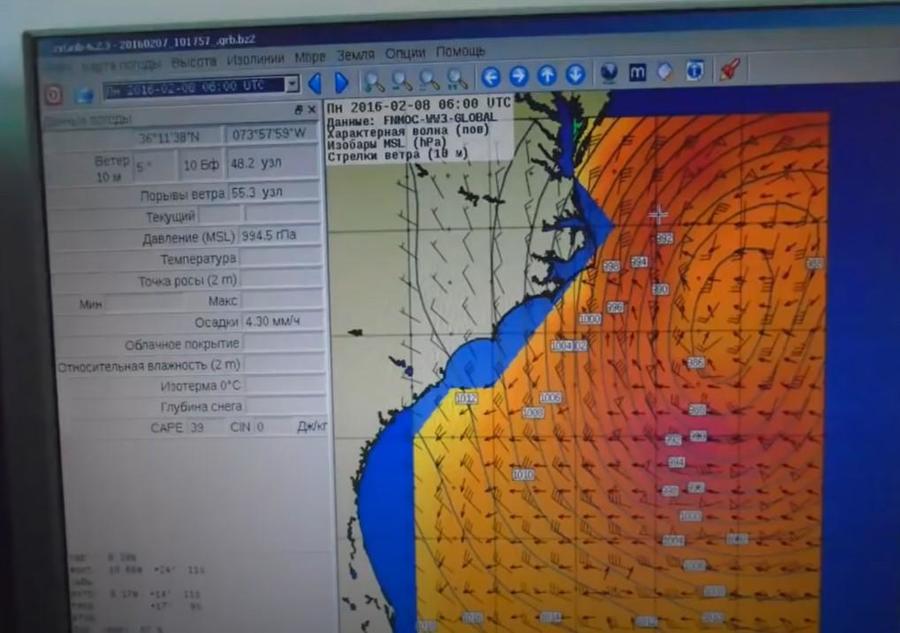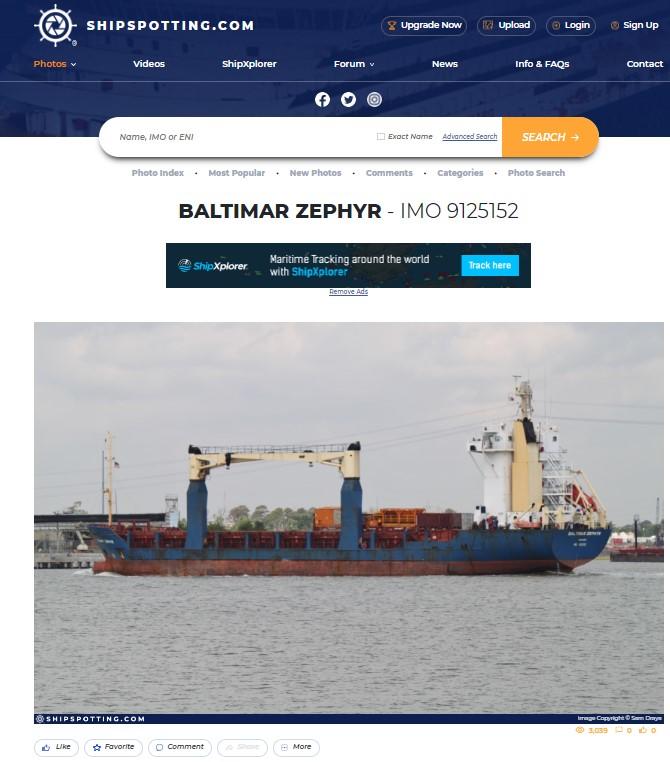
Did salt water and car batteries cause a fire that spread through the motor vehicles loaded on the top on the deck of a cargo ship? Yes, that is possible: In an insurance trade magazine report, the appointed surveyor who investigated the 2016 incident on board the Baltimar Zephyr said the presumed cause of the fire was a short circuit in the electrical wiring of the transported cargo. This report did not specify that salt water was the reason for the short circuit, although that is a distinct possibility. There is no indication that the fire was caused by a lithium-ion battery in an electric vehicle. The surveyor further noted that the fire led to the ignition of combustible and lubricating materials that spread the fire to the tween deck and cargo hold of the vessel, which appears not to have been a modern weather-sealed roll-on/roll-off car carrier.
A dramatic video showing a ship loaded with cars on fire at night in a storm has been circulating online. The earliest edition of this video Lead Stories has identified is a four-minute, 26-second video posted on YouTube by @Navi on November 7, 2019, (now called the Navi video for this article). Other copies of the video circulating are much shorter. One version, only 18 seconds long, was posted on Twitter (archived here) by RG Poulussden on May 29, 2023. It was captioned:
Car batteries and salt water.
This is what the post looked like on Twitter at the time of writing:
(Source: Twitter screenshot taken on Wed Jun 7 15:45:05 2023 UTC)
The videos did not state the name of the ship or the cause of the fire. Lead Stories tried to discover what happened, starting with reverse image searches using Google, Yandex and TinEye, with screenshots of the scenes in the video. These searches did not turn up any factual details about the incident despite the video having been circulated to international audiences with captions in many languages. One March 18, 2021, article in Russian used a photo of the fire to illustrate an article about an entirely different incident at the Russian port of Fokino, saying there was a torpedo that exploded on a Russian anti-submarine warship while unloading. That entirely separate incident was denied by Russian defense officials.
The storm
The Navi video begins with a four-second still photo of a computer screen readout (pictured below). It shows weather data along the coastline of the mid-Atlantic United States. The readout is displayed in Cyrillic type. This image contains critical clues -- the date and time, and the coordinates.
(Image source: YouTube screenshot taken on Tue May 30 14:15:33 2023 UTC)
There was a newsworthy storm in the Atlantic through the night of February 7 and 8, 2016, but the news coverage was not about this cargo ship. A Royal Caribbean cruise ship named Anthem of the Seas was carrying about 4,000 vacationers to the Bahamas from Cape Liberty, New Jersey, when it was caught in this storm off Charleston, South Carolina. An ABC News article reported the cruise ship encountered 30-foot waves and 76 mph winds (Category 1 hurricane force). A Royal Caribbean Group tweet on February 8, 2023, reported the ship would be returning to Cape Liberty and passengers would be getting a full refund.
Identifying the ship in the video
Did the storm data provide clues to the name of the ship pictured in the video? This could be the big break. Lead Stories reached out to the press office of the ship tracking and maritime analytics provider MarineTraffic with the information gleaned from the weather data image: UTC Date -- Mon 2016-02-08 06:00 and the coordinates, 36° 11'38"N, 073° 57'59"W. Several days later the MarineTraffic data team had narrowed down the possibilities considerably. On June 6, 2023, Lead Stories received an .xlsx file by email containing the International Maritime Organization number (IMO) and names of six ships, along with the data on the time and position recorded when they were tracked in that 2016 storm.
Using the websites marinetraffic.com, vesselfinder.com and shipspotting.com, images of the six ships could be compared to features visible in the Navi video. Only one of the ships matched the design of the ship in the video, but the cargo booms of the ship pictured were painted red, not blue and off-white as pictured in the video. Since 2016 the ship has been repainted, and the name of the ship has changed several times, but the IMO number always remains the same. In the past the ship did have blue-and-off-white boom cranes and was named Baltimar Zephyr.
(Image source: shipspotting.com screenshot taken on Wed Jun 07 21:23:57 2023 UTC, photo by Sam Draye taken on April 22, 2013)
Was there a fire on board during the storm?
The name of the ship yielded several specific mentions on record of the cargo fire on the Baltimar Zephyr. A 2018 court case in the State of Delaware, JEANINE v. NAVA, was dismissed without prejudice because the court lacked jurisdiction. It concerned the loss of merchandise that a woman was shipping to Haiti. The following paragraph from the case names the ship and briefly describes the fire:
Defendant's testimony at trial stated that he delivered the tractor trailer container to the port in Brooklyn, New York sometime in early February 2016. The shipping container was then loaded onto the Baltimar Zephyr cargo ship and set sail for Haiti shortly thereafter.2 The Defendant informed Plaintiff that the cargo had shipped and in reliance thereon, Plaintiff traveled to Haiti to organize and sell her merchandise. After sailing for two days out of Brooklyn, New York, a fire occurred onboard the Baltimar Zephyr and Defendant's container (including Plaintiff's merchandise) was jettisoned overboard during the crewmember's attempts to fight the fire and save the ship. Plaintiff then filed this breach of contract action to recover the value of her lost merchandise, alleging Defendant never transported the goods to Brooklyn nor shipped them to Haiti.
The Baltimar Zephyr is listed as a claim that Russian insurance company Ingosstrakh paid. The company published a promotional booklet for their marine insurance offerings. Seventeen of the major H&M (Hull and Machinery) claims paid by Ingosstrakh for the preceding five years are listed on page 15 of the .pdf file,. Near the bottom of the list is the Baltimar Zephyr:
USD 1 387 000 - m/v Baltimar Zephyr, fire on deck (2016)
Details of the insurance payment are in a November 22, 2017, press release published by bfm.ru in Russian and forinsurer.com in Ukrainian, titled "'Ingosstrakh' paid $1.3 million for the fire on the ship Baltimar Zephyr, which was traveling from the USA to Haiti." The following paragraph was translated by Google -- the term surveyor is the correct terminology for a specialized field of marine inspector. The hold covers mentioned make up the deck of the ship. They are not a solid permanent deck, but are panels that can be moved out of the way as needed, allowing the ship's hold to be loaded with loose material such as scrap metal (pictured here).
The insured event occurred on February 8, 2016, when during the journey from New York (USA) to the port of Saint-Marc (Haiti) during a strong storm, a cargo of cars caught fire on the deck of the Baltimar Zephyr. According to the nominated surveyor, the probable cause of the fire is a short circuit in the electrical wiring of the transported cargo, which was located on the hold covers, with further ignition of combustible and lubricating materials and spread to the twin deck [tween deck] and the hold of the ship.




















